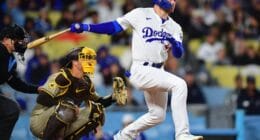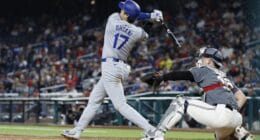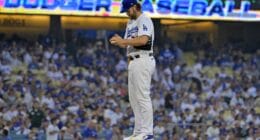
25. Jacob Scavuzzo, OF
A 21st-rounder in 2012, Scavuzzo was an uber athletic outfielder from Orange, Calif. He played wide receiver for his high school football team, but the Dodgers signed him away from the gridiron.
Scavuzzo had some ups and downs in the beginning of his career, with a pair of disappointing seasons sandwiched around a successful stint in Ogden. But he broke out in 2015, hitting .286/.337/.500 with 32 doubles and 18 home runs between Rancho Cucamonga and Tulsa.
Scavuzzo then went on to the Arizona Fall League, where he batted .377/.389/.623 in 16 games. He seemed primed for a big season in 2016.
Unfortunately, his body had other plans. Scavuzzo injured his elbow during the year and tried to play through it, but it took a toll on his production. He hit just .266/.318/.397 for the Drillers, with 10 home runs in 112 games.
When he’s healthy, Scavuzzo looks like a potential five-tool player. He has plenty of raw power and generally makes enough contact to get to it in games. He’s not a burner but a good runner for someone his size (6’4 and a decent bit more than the 185 pounds he was when he signed).
Scavuzzo can cover plenty of ground in the outfield, though his arm is probably best suited for left field. After undergoing surgery on his elbow this spring, Scavuzzo should be able to break camp with the Drillers.
With two healthy arms, he should be ready to re-establish himself as a legitimate outfield prospect at the ripe old age of 23.
24. Edwin Rios, 1B
Coming into 2016, Rios was a big body with power that hadn’t really been tapped into it yet. He hit .253/.317/.467 with three homers in 22 games between both rookie league affiliates.
Last season, Rios struggled out of the gate again. He batted just .222/.282/.347 with two homers in his first 20 games. But something clicked and he took off. He finished May on a high note and earned a promotion to Rancho, where he turned into Babe Ruth.
In 42 games with the Quakes, Rios hit .367 with 16 home runs, including 11 in July alone. He then added six more long balls in 33 games with the Drillers, giving him 27 in just 108 games overall.
Listed at 6’3 and 220 lbs., Rios might actually be bigger and generates a lot of raw power from the left side. He has a natural uppercut to his stroke, which results in both home runs as well as strikeouts. He kept his strikeout rate under 25 percent last season, which is acceptable given his power numbers.
The other side of the ball is where the major questions lie. While Rios has played third base the majority of the last two years and has plenty of arm for the position, he’s not a great athlete and doesn’t move too well. He also doesn’t have the softest of hands. He could try a corner outfield spot, but he’s not a great runner.
Rios will likely begin this season back with Tulsa and will need to work on his defense in order to prove he has Major League potential. If he doesn’t establish himself defensively, the 22-year-old will need to improve his plate discipline to pass as a first baseman.
If that doesn’t happen, he’ll likely top out as a “Quad-A” player who will belt 25-plus home runs a year.
23. Omar Estevez, 2B
Yet another bonus baby. Estevez was signed for $6 million in November of 2015. He played part of a season in Cuba in 2014, so it was a slight surprise that the Dodgers threw him into full-season ball in his debut at the age of 18.
With the Loons, Estevez batted .254/.298/.388 with 32 doubles and nine home runs. He hit better against righties (.752 on-base plus slugging percentage) than lefties (.530). He got better as the season went on, raising his OPS by more than .200 points.
Listed at 5’10 and a very modest 168 lbs., Estevez moves well for his size and has made some nice plays at shortstop. However, he has a thicker frame than your usual shortstop and probably profiles better at second or third, but he’ll likely stay up the middle until he can’t play there anymore.
Estevez has enough arm for the left side of the infield and his hands will keep him from moving to the outfield. At the plate, he shows some strength and leverage with his swing, but it can get long and his timing comes and goes.
Estevez incorporates a leg kick, which isn’t a bad thing, but he struggles when he’s late and needs to get his foot down on time. Estevez enters this as a 19 year old and will be one of the youngest players in the California League.
He’s moving up a level, but could benefit from a far friendlier environment.
22. Josh Sborz, RHP
The 2015 season was a good year for Sborz. His University of Virginia Cavaliers won the College World Series, Sborz was named the MVP of the tournament and then he was selected in the second round of the draft.
He debuted with Ogden, moved up to Great Lakes, and finished the year by winning a California League championship with Rancho Cucamonga. Not a bad summer. Last year, Sborz moved into the rotation with the Quakes and pitched well.
In 20 games, he made 19 starts and posted a 2.66 ERA in 108.1 innings with 108 strikeouts. Sborz then moved up to Tulsa and pitched out of the bullpen to limit his innings, surrendering a 3.78 ERA in 10 games with 17 strikeouts in 16.2 innings.
Sborz starts off with a fastball that sits in the low to mid 90s. He compliments that with a plus slider and will toss in a curveball and changeup, giving him a starter’s repertoire. Sborz generally does a good job of throwing strikes and keeping the ball in the park.
There is some question about his ultimate role. While he began last year as a starter, it’s unclear whether he’ll remain a starter long term, or even this year.
This ranking represents Sborz’s value as a reliever, capable of throwing multiple innings like he did in college. If he returns to the rotation and succeeds, obviously he’ll rank higher on future lists.
21. Johan Mieses, OF
Mieses signed in May of 2013 without much fanfare and immediately debuted in the Dominican Summer League. Unfortunately, he struggled in his initial taste of pro ball, hitting just .222 in 16 games.
The following year, he returned to the DSL and blew the roof off, batting .299 with an .876 OPS. He came stateside in 2015 and hit well in Great Lakes before moving up to Rancho. Last year was Mieses’ second coming out party.
After hitting just 16 home runs in his first 171 games, he clubbed 28 in 122 games with the Quakes. While he has to work on his hitting, Mieses has some of the most exciting tools in the system.
His raw power, speed and arm strength are all very good and he plays right field very well. His main issue is his approach at the plate. Mieses has an extreme free swing and struck out 147 times compared to 36 walks.
He will move up to Tulsa as a 21 year old, which will be a daunting task to improve his offensive game plan while simultaneously facing much more advanced competition. If he takes another step forward, Mieses could become one of the better hitting prospects in the system.





